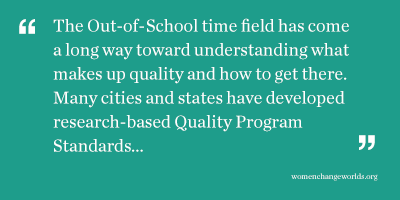
On December 10th, President Obama signed the Every Student Succeeds Act (ESSA), which includes several provisions for out-of-school time (OST). Importantly, the act gives more flexibility to state education agencies to put resources toward training, professional development, and quality improvement for OST programs and staff. At the National Institute on Out-of-School Time (NIOST), we are strong believers in the power of quality programs, and are working to help the field achieve quality for all.
As OST begins to take on a larger role--with more than 10.2 million children and youth now participating in OST programs, public and private investments in afterschool programs increasing dramatically over the last two decades, and the nation’s leaders looking to afterschool programs to help with everything from closing the achievement gap to improving our kids’ social emotional skills--quality programming is more essential than ever. Not just any program will help achieve desired student outcomes. We have a solid research base showing that program quality is what determines whether programs meet their youth developmental and academic goals, and that higher quality programs deliver better experiences for kids (see, for example, this research). However, quality is uneven across, and even within, afterschool programs.
 So, how do we promote and ensure quality? One major key is staff training and professional development. Since NIOST’s early role in the Massachusetts Afterschool Research Study (2005), which found that programs with more highly educated and trained staff demonstrated greater staff and youth engagement and better activities than programs with less educated and trained staff, evidence has been mounting that professional development and staff training can significantly affect program quality. In short, OST programs need to be of high quality to have a positive impact, and a main path to quality is through staff training. But, of course, it’s a bit more complicated than that. Where is an OST program to begin? How do you know quality when you see it, and what should staff training and professional development look like?
So, how do we promote and ensure quality? One major key is staff training and professional development. Since NIOST’s early role in the Massachusetts Afterschool Research Study (2005), which found that programs with more highly educated and trained staff demonstrated greater staff and youth engagement and better activities than programs with less educated and trained staff, evidence has been mounting that professional development and staff training can significantly affect program quality. In short, OST programs need to be of high quality to have a positive impact, and a main path to quality is through staff training. But, of course, it’s a bit more complicated than that. Where is an OST program to begin? How do you know quality when you see it, and what should staff training and professional development look like?
The OST field has come a long way toward understanding what makes up quality and how to get there. Many cities and states have developed research-based Quality Program Standards and Core Knowledge and Competencies for professionals (like those adopted by the National Afterschool Association) defining quality programs and practice. Continuous Quality Improvement--a process by which one defines quality, assesses it, and then works to support its growth and development--is becoming commonplace.
Assessment tools can further help programs measure components of quality and guide professional development. They can also empower OST professionals to build the skills they need to improve quality. The Assessment of Program Practices Tool (APT), part of NIOST’s Afterschool Program Assessment System, is designed to help programs evaluate and strengthen practices that research suggests are linked with positive youth outcomes. Combining observation and self-assessment, APT looks at the overall afterschool program, homework time, and activities. It helps staff observe and demonstrate their skills, characteristics, and program features that contribute to measurable positive child and youth outcomes.
It’s great to see federal lawmakers agreeing that quality matters in OST. With clarity of vision from an assessment tool, programs can focus their staff training and professional development on areas that need improvement, and best leverage the ESSA funding.
Betsy Starr, M.Ed.is a research associate at the National Institute on Out-of-School Time (NIOST) at the Wellesley Centers for Women. Her work focuses on professional development and system-building for the field of afterschool and youth development. (Video: Ellen Gannett, M.Ed., is director of NIOST.)
When you subscribe to the blog, we will send you an e-mail when there are new updates on the site so you wouldn't miss them.
Comments